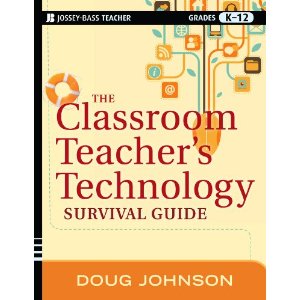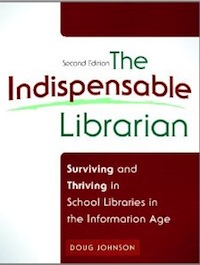Self-evaluation Rubrics for Basic Administrative Technology Use, 2013
These are the updated version of the 2002 CODE77 Rubrics for Administrators and 2010 Rubrics. Your comments and suggestions for improvement are welcome. The rubrics can be viewed as a GoogleDocs form here. - Doug
Self-evaluation Rubrics for Basic Administrative Technology Use, 2013
I. Personal Productivity (NETS-A 2009 - 3c, 4e)
Level One: I rarely use a computer or other information technology, assigning technology-enabled professional record-keeping and communication to my office staff. I am not aware of or have interest in learning about using a computer, smartphone, tablet, or other digital communication and information access device.
Level Two: I use a computing device to keep a calendar to which my secretary has access; to track addresses and phone numbers of professional contacts; and to compose/review professional correspondence. I use technology to do routine tasks more effectively and efficiently, which gives me more time for work with staff and on long-term goals and major projects. I can access my calendar and other information remotely using a portable communication device that has Internet access.
Level Three: I not only use technology to increase my productivity, but encourage my office staff to do so as well. All correspondence from my school looks professional. All building/district staff use a shared calendar system for easy scheduling of meetings and shared document creation applications for collaborative work. My school has nearly a paperless work flow, providing both economic and ecological benefits.
II. Student Information Systems Use (NETS-A 2009 - 4b. 4e)
Level One: My office uses a student information system (SIS) to accurately track student information including parent/guardian contact information, grade reports, discipline reports, and health records. The system is used to build a master class schedule. Selected building personnel and I can access the SIS through the network and use it for decision-making purposes. I can access the system from my smart phone or tablet computer. The system is secure and back-up procedures are in place.
Level Two: Appropriate student information is used by all staff as well as by building leaders. Teachers are trained and proficient in the use of the SIS. The system is integrated with a district census database that is also tied to finance, transportation, and personnel/payroll records. I know the philosophy of SIF (School Interoperability Framework) and use it as a criterion when selecting new or upgraded information systems. The district information plan has these attributes:
- record and maintain basic student contact information including address, parent-guardian information, and telephone information
- track student attendance
- record and maintain student course grades, credits and completion of other graduation requirements
- calculate grade point averages and class rank
- create transcripts
- maintain discipline records
- develop class schedules, register students for classes, and create class lists
- maintain student health records
- generate reports
- generate report cards, progress reports, letters to parents and mailing labels
Level Three: The information system is used as a communication tool to inform parents/guardians and students of real-time student work reporting. Using a secure portal, parents/guardians and students themselves can access demographic data, attendance, grades, schedules and gradebook information including test scores, quizzes and daily work completion information. The data in the student information system is used with telephone calling and e-mailing systems to communicate with households. The system integrates with state reporting systems and with data warehousing/data mining programs. All my staff update information in the reporting section of the SIS on a regular basis.
III. Record Keeping and Budgeting (NETS-A 2009 - 3a)
Level One: I use and prefer a paper system, a spreadsheet or simple packaged record keeping system to track my department or building’s budget accounts. It is accurate and kept up-to-date. I can use my accounting system to cross check the district’s financial system if discrepancies arise.
Level Two: I use the district’s online accounting system to track my budget accounts. My office can submit purchase orders electronically. My school uses networked inventory databases to keep track of my building’s textbooks, supplies, and equipment. My school uses the library automation system to check out textbooks and equipment, as well as library books.
Level Three: I give access to the accounts I manage to anyone interested in the spirit of transparency. I use shared budgeting tools that allow a collaborative budgeting process working with a wide range of stakeholders.
IV. Data Use (NETS-A 2009 - 4b, 4c)
Level One: I do not use, or have available to me, reports or data produced by information systems in the district to help make operational or policy decisions.
Level Two: I can analyze census, discipline, scheduling, attendance, grading, and financial data reports produced by administrative systems to spot trends and highlight problems in my building or department. I can communicate the conclusions to staff, parents, and the community in understandable ways. I help my staff access, analyze and use student performance data to design instructional strategies. I have the statistical knowledge to make meaningful and accurate judgements based on data.
Level Three: I recognize areas in administration for which additional data is needed for the efficient and effective operation of the building, department, or district and can make recommendations about how that data can be gathered, stored, and processed electronically. I can use data mining techniques to draw conclusions about programs’ effectiveness and use such data to create building plans and evaluated their success.
V. Communications and Public Relations (NETS-A, 2009 - 3c, 5d)
Level One: I ask that my secretary word process out-going communications. When I speak to the public, I use overhead transparencies or no audio-visual aids. I do not have a professional online presence.
Level Two: I effectively use a variety of technologies to communicate with students, teachers, parents, and the public. I use e-mail. When speaking, I can use presentation software and the necessary hardware to effectively communicate my message. I use the district’ or building’s video capabilities for public information uses in the school and community. I have presence on the district’s website that is current and useful to students, staff, parents, and the community. I can use the mass calling, texting, and e-mail systems in our district to notify the public of events and emergencies.
Level Three: I communicate online using a variety of technologies - blogs, wikis, podcasts, videos, microblogging (Twitter), and emerging technologies. I contribute policy advice for our school’s web pages. I encourage my staff to use technology to communicate with each other, students, parents, and the public. The public is encouraged to communicate electronically with the school. I understand the powerful impression that my school’s online presence can play in the public perception of the school and can use online tools for recruiting and keeping students. I am cognizant of my own “digital footprint” as a professional.
VI. Online Research, and Professional Development, and Personal Learning Networks (NETS-A 2009 - 2d, 3b, 3d)
Level One: I prefer not to use online resources to gather professional information or research nor do I use technology to communicate with my peers to share information.
Level Two: I can effectively search and extract information from online resources such as educational journal databases, ERIC, and other credible sources on the Internet. I subscribe to electronic journals and newsletters of professional relevance. I subscribe to electronic mailing lists (listservs) and RSS feeds of blogs and news sites to gather information and problem-solve with fellow professionals. I have participated in educational forums or training delivered online.
Level Three: I use technology to remain actively engaged by contributing to an on-going professional learning community of my peers.
VII. Teacher Technology Competencies (NETS-A 2009 - 3a, 4c)
Level One: I cannot specifically identify any specific skills teachers in my school or district should have in order to use technology effectively. My school or district has no written set of technology skill competencies for teachers.
Level Two: Our school or district has a set of technology skills that teachers are expected to master correlated to the NETS-T or other national standards. A formal staff development program that offers teachers a range of staff development opportunities in technology and a means for assessing the effectiveness of those opportunities is in place. The effective use of technology in supporting all teaching improvement efforts is recognized and addressed in staff development initiatives.
Level Three: All teachers are expected to use technology to increase their pedagogical effectiveness and integrate high-level technology uses into their classes when appropriate. I can identify effective technology uses in the classroom and know how they support other effective teaching practices such as Danielson’s Frameworks for Learning.
XIII. Student Technology Competencies (NETS-A, 2009 - 2a)
Level One: I cannot identify any specific skills students in my school or district should have in order to use technology effectively after graduation to be successful students, workers, or citizens.
Level Two: My district has a well-articulated and well-taught information literacy curriculum that integrates technology into a problem-solving research process. I help assure that my school has a librarian who provides instruction to both students and staff in these skills. Students have a wide variety of opportunities in all classes to practice the use of technology in meaningful ways. Benchmarks for student technology proficiency are written and understood by the staff and public. Our curriculum is based on national standards such as NETS or AASL’s Information Literacy Standards for Student Learning.
Level Three: I serve on curriculum committees comprised of both educators and community leaders that help identify the skills and competencies future graduates will need to successfully participate in society. I can clearly articulate how technology use impacts student achievement. I work to make sure technology access is adequate to meet all students’ learning needs.
IX. Envisioning, Planning, and Leading (NETS-A, 2009 - 1a, 1b. 1c)
Level One: I let others in my district or school create technology plans. We purchase equipment, software, and technical support on an as-needed basis.
Level Two: I use software to facilitate brainstorming activities, to plan and conduct meetings, and to create decision-making models. I take an active leadership role in building and district technology planning efforts helping make decisions about hardware selection and acquisition, staff development in technology, and integration of technology into the curriculum. Our school and district have a long-range plan and short-term goals for technology use that are regularly assessed and updated. I have a personal philosophy I can articulate regarding the use of technology in education.
Level Three: I have a leadership role in my professional organization that stresses the effective use of technology in education. I write and speak for my fellow practitioners on technology issues. I work to inspire others to use technology when it supports best practices in education.
X. Ethical Use, Student Safety and Policy Making (NETS-A, 2009 - 5a, 5b, 5c)
Level One: I do not feel I need to be concerned with any ethical, safety, or policy issues surrounding computer use.
Level Two: I understand copyright and fair use issues as they apply to information technology resources. I demonstrate ethical usage of all software and let my staff know my personal stand on legal and moral issues involving technology. I know and enforce the school’s technology policies and guidelines, including its Internet Acceptable Use Policy and policies relate to the use of social networking tools by the professional staff. I am aware of the issues as technology relates to student safety and security and the physical health and environmental risks associated with technology use. I have a personal philosophy I can articulate regarding the use of technology in education.
Level Three: I am aware of other value-laden aspects of technology use including data privacy, equitable access, and free speech issues. I can speak to a variety of technology issues at my professional association meetings, to parent groups, and to the general community. I encourage all staff members in all classes to address the issues of safe and responsible use of technology and the Internet.




